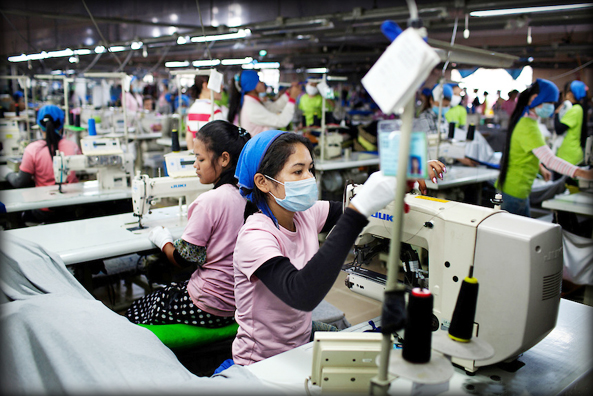|
Apparel employment, trade and economic development:
Stitches to riches
Female labour, especially low-skilled labour, is very responsive to
higher wages. A one percent increase in the expected wage increases the
likelihood of women joining the labour force by between 16 percent in
Pakistan and 89 percent in Sri Lanka, according to a report by the World
Bank released last week.
Titled 'Stitches to Riches', the report further said that a wage
premium exists in the apparel sector compared to agriculture that ranges
from 8 to 27 percent, depending on the country - a premium that is even
higher when only women are considered. However, this premium has stopped
rising in all SAR countries (Pakistan, India, Sri Lanka and Bangladesh)
and besides Bangladesh with the end of the Multifibre Arrangement (MFA)
in 2005.
Given the significant variation in export patterns, this report also
sought to find out how apparel buyers' preferences fit in.
|

Garment workers make Adidas apparel at the Shen Zhou garment
factory in Phnom Penh, Cambodia. |
In Sri Lanka working conditions are generally better than in the
other South Asian countries (National Stakeholders 2014). To improve the
international and local image of the apparel industry, the Joint Apparel
Association Forum (JAAF) established the "Garment without Guilt"
initiative in 2006-which includes a certification program-as part of the
Five-Year Strategy following the end of the Multifibre Arrangement
(MFA). Compliance and political stability are strong areas for Sri
Lanka, and the country has attracted partnerships with ethically
oriented buyers, including M&S, Nike, and Victoria's Secret (Global
Apparel Buyers 2014; National Stakeholders 2014).
For the EU market, the most striking result is the large difference
in the prediction for Sri Lanka, whose elasticity is very high (table
O.3, panels c and d).
The results suggest that a 10 percent increase in Chinese apparel
prices would increase Sri Lankan male apparel employment by 8.55
percent, followed by India (4.30 percent); but Bangladesh and Pakistan
would experience small decreases because their trade estimates do not
suggest that they are close substitutes for Chinese apparel products in
the EU market. For females, the results are qualitatively similar in
that female employment in Sri Lanka now would appear to increase by 7.87
percent, while the other countries are predicted to have a small change.
Again, the exception might be India. If China's prices to Europe
increase by 10 percent, India could have a 3.26 percent increase in
female employment. Therefore, an increase in demand could draw many new
workers into apparel.
Sri Lankan apparel prices are higher than those of competitors in
most product categories, and its product portfolio is largely made up of
higher-value, niche products. Average literacy in Sri Lanka is higher
than in other South Asian countries, and a more skilled workforce also
allows them to produce more sophisticated apparel products. Sri Lanka
stands to gain significantly from increasing its apparel exports,
particularly to the EU market.
Elasticity estimates highlight that a 10 percent increase in Chinese
apparel prices could increase Sri Lankan male employment by 8.55 percent
and female employment by 7.87 percent.
SAR group countries - with the exception of Sri Lanka - generally
appear to be cost competitive in apparel but fare less well on other
factors important to global buyers such as quality, lead times,
reliability, and social compliance.
Sri Lanka could benefit from policies to diversify its export
markets, attract additional foreign investment, and capitalize on its
skills advantage by producing new, more sophisticated products. To help
firms diversify end markets and export destinations for existing
products, policy makers might consider more trade agreements with
potential partners - foreign investment remains at 2 percent of GDP,
even five years after the end of armed conflict.
Also helpful might be adopting clear investment policies to portray
stability and attract additional investment. To capitalize on Sri
Lanka's skills advantage, firms could expand into new products such as
formal wear and high-end outerwear that require higher skills. Finally,
policy makers could position Sri Lanka as a regional apparel and textile
trade hub, taking advantage of infrastructure and location.
The results of the benchmark analysis indicate that, overall, the
SEAB countries and China are outperforming the SAR countries in terms of
aggregate export performance, product diversity, and non-cost-related
factors important to global buyers. SAR countries - with the exception
of Sri Lanka - generally appear to be cost competitive for selected
product categories, but are inhibited by product concentration and
inferior performance compared to competitors in non-cost-related factors
(including quality, lead times, reliability, and compliance).
-CJ
|

